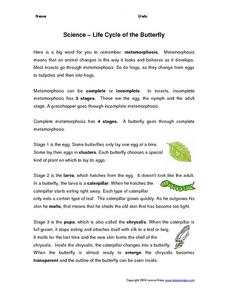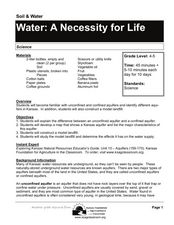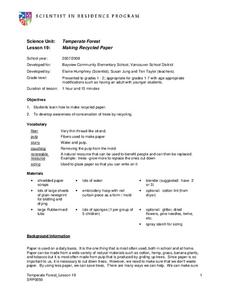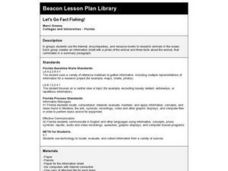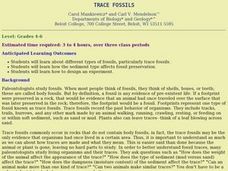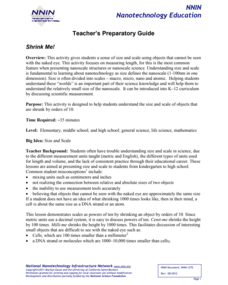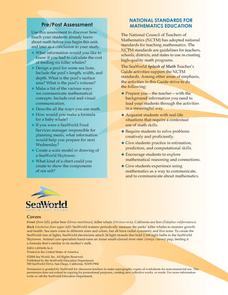Curated OER
Plants and Ecosystems
The relationships within and between ecosystems can be explored. after examining an area for living and non-living things students complete the same examination in the forest ecosystem. Students identify abiotic and biotic elements in an...
California Academy of Science
Kinesthetic Astronomy: The Meaning of a Year
How many times have you traveled around the sun? Aspiring astronomers grasp what a year is and they differentiate between orbit and rotation by walking around the sun right within your classroom. Place a lamp in the center of the room to...
Curated OER
Science - Life Cycle of the Butterfly
In this butterfly worksheet, students learn about the 4 stages that a butterfly goes through during metamorphosis. They then use what they learned to answer the 9 questions on the page. The answers are on the last page of the packet.
Curated OER
Life Cycles
For this plant life cycle worksheet, learners study the diagram of the flower. Students match the term and description that fits each part of the flower.
Curated OER
It's Alive! Or is it?
Students differentiate the characteristics of living and nonliving things. In this life science lesson, students compare and contrast robots and living things. Given an object, they decide whether it's is living or not and defend...
Curated OER
Marine Debris
Learners will perform experiments to examine if debris will float, or blow in the wind. They discuss the effects of these characteristics on marine debris.
Curated OER
Salmon Life Cycle
In this life cycle worksheet, students fill in the blanks with words about the life cycle of a salmon. Students complete 20 words about the life cycle.
Curated OER
Shadow Know-How: Marine Animals
In this fill in the blank worksheet, students identify the names of ten marine mammals by analyzing their outlines in shadow pictures.
Curated OER
A Day In My Life
Students brainstorm how they can conserve energy in their daily lives. For this energy lesson plan, students discuss how they use energy and ways to conserve it.
Curated OER
Local River Life
Students identify rivers in their county, state, or province, and
research various kinds of animals and plants living in or near the rivers.
They write short summaries about the animals and plant life, draw pictures, and compile...
Curated OER
Water: A Necessity for Life
Students examine types of aquifers and make a model landfill. In this water usage lesson, students determine the difference between confined and unconfined aquifers. They build a model landfill, observe it for two weeks, and analyze what...
Curated OER
Science: Bees: An Interdisciplinary Approach
Students investigate the world of bees and describe their characteristics. by identifying the bees' parts, they demonstrate how these parts function. In the lab, students dissect bees and view the various parts under microscopes. ...
Alabama Learning Exchange
Making and Observing Life in a Terrarium
Young scholars understand the parts of the terrarium and why they are important in establishing an ecosystem. In this ecosystem lesson, students recall background information on aquariums, terrariums and the water cycle. Young scholars...
Curated OER
Making Recycled Paper
Students explore paper making. In this tree conservation ecology lesson, students brainstorm ways paper is used in daily life. Students examine paper fiber using a magnifying glass. Students make paper following a step by step procedure...
Curated OER
Analyzing Intertidal and Deep Sea Vent Communities
Students study how scientists measure diversity. In this diversity lesson students look at marine communities and look at data to calculate diversity in 3 different ways.
Curated OER
Let's Go Fact Fishing!
Learners work in pairs to research animals in the ocean. They use the Internet, encyclopedias, and resource books to complete an information sheet with a photo of the animal and three facts. They present their mini-reports to the class.
Curated OER
The Building Blocks of Life: Cell Building
Students view a short video from www.unitedstreaming.com. They then construct parts of a cell by building a model of an animal and plant cell using regular household materials.
Curated OER
The Circle of Life: Food Chain
Learners develop a flow chart using computer software to show a food chain combination. In this food chain lesson, students are first read The Great Kapok Tree by Lynne Cherry, then they create a story map of the story. Next,...
Curated OER
Science: Making Trace Fossils
Students explore types of fossils and discover how sediment affects fossil preservation. They focus their study on trace fossils and create their own using sediment, water, and a small organism such as a snail or lizard. Students use...
Curated OER
Applied Science -Physics (4A) Post Lab
Fourth graders explore the history of electricity. In this electricity instructional activity, 4th graders review the connection between electricity and magnetism. They do a research project on the history of electricity.
Curated OER
Pond Ecology
A lab activity is a great way to incite thoughtful questioning and scientific processes. Pupils will collect organisms with a Petri dish, make observations, sketch the organism, ask questions, then attempt to identify the specimen...
National Nanotechnology Infrastructure Network
Shrink Me!
The incredibly shrinking meter—decimeters to centimeters, to millimeters, and now to nanometers! Learners may have a difficult time visualizing particles on a nanoscale. Help them see a little clearer using a well-designed lesson...
Curated OER
Creature From The Deep
Students become familiar with oceanography terms by writing an oceanography horror story.
Sea World
Splash of Math
How can kids use math to learn about marine life? Combine math skills with science lessons in a resource featuring activities about life in the sea. Kids graph and calculate data, solve complex word problems, measure geometric shapes,...


